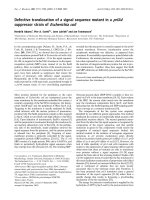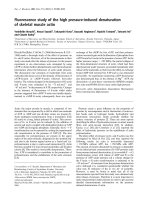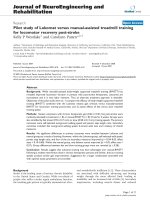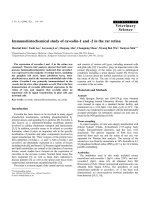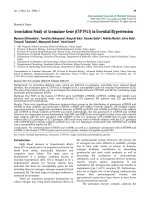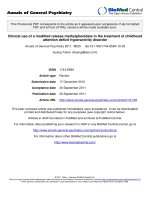Báo cáo y học: "Pilot study of losartan for pulmonary hypertension in chronic obstructive pulmonary disease" ppt
Bạn đang xem bản rút gọn của tài liệu. Xem và tải ngay bản đầy đủ của tài liệu tại đây (301.82 KB, 10 trang )
BioMed Central
Page 1 of 10
(page number not for citation purposes)
Respiratory Research
Open Access
Research
Pilot study of losartan for pulmonary hypertension in chronic
obstructive pulmonary disease
Nicholas W Morrell*
1
, Matthew A Higham
1
, Peter G Phillips
1
, B
Haleema Shakur
1
, Paul J Robinson
2
and Ray J Beddoes
2
Address:
1
Department of Respiratory Medicine, Imperial College School of Medicine, London, UK and
2
Medical Department, Merck Sharp &
Dohme Limited, Hoddesdon, UK
Email: Nicholas W Morrell* - ; Matthew A Higham - ; Peter G Phillips - ; B
Haleema Shakur - ; Paul J Robinson - ; Ray J Beddoes -
* Corresponding author
Abstract
Background: Morbidity in COPD results from a combination of factors including hypoxia-induced
pulmonary hypertension, in part due to pulmonary vascular remodelling. Animal studies suggest a
role of angiotensin II and acute studies in man concur. Whether chronic angiotensin-II blockade is
beneficial is unknown. We studied the effects of an angiotensin-II antagonist losartan, on
haemodynamic variables, exercise capacity and symptoms.
Methods: This was a double-blind, randomized, parallel group, placebo- controlled study of 48
weeks duration. Forty patients with COPD and pulmonary hypertension (Tran tricuspid pressure
gradient (TTPG) = 30 mmHg) were randomised to losartan 50 mg or placebo. Changes in TTPG
were assessed at 3, 6 and 12 months.
Results: There was a trend for TTPG to increase in the placebo group (baseline 43.4 versus 48.4
mmHg at endpoint) and stay constant in the losartan group (baseline 42.8 versus 43.6 mmHg).
More patients in the losartan group (50%) than in the placebo group (22%) showed a clinically
meaningful reduction in TTPG at any timepoint; these effects seemed more marked in patients with
higher baseline TTPG. There were no clear improvements in exercise capacity or symptoms.
Conclusion: In this 12-month pilot study, losartan 50 mg had no statistically significant beneficial
effect on TTPG, exercise capacity or symptoms in pulmonary hypertension secondary to
obstructive disease. A sub-group of patients with higher TTPG may benefit.
Background
Pulmonary hypertension is the main cardiovascular com-
plication of chronic obstructive pulmonary disease
(COPD) and is associated with a substantial increase in
morbidity and mortality [1-3]. The major characteristic of
COPD is chronic airflow limitation that progresses slowly
over a period of years and is, by definition, largely irrevers-
ible [4]. We previously reported echocardiographic evi-
dence of pulmonary hypertension in over 50% of patients
attending a hospital clinic for COPD [5], with the highest
prevalence in those with severe disease.
Alveolar hypoxia undoubtedly contributes to pulmonary
hypertension in COPD and there is a correlation, albeit
Published: 01 August 2005
Respiratory Research 2005, 6:88 doi:10.1186/1465-9921-6-88
Received: 11 April 2005
Accepted: 01 August 2005
This article is available from: />© 2005 Morrell et al; licensee BioMed Central Ltd.
This is an Open Access article distributed under the terms of the Creative Commons Attribution License ( />),
which permits unrestricted use, distribution, and reproduction in any medium, provided the original work is properly cited.
Respiratory Research 2005, 6:88 />Page 2 of 10
(page number not for citation purposes)
poor, between the pulmonary artery pressure and the
degree of arterial hypoxaemia [6,7]. Structural remodel-
ling of the pulmonary vasculature as a consequence of
chronic alveolar hypoxia is probably the main contributor
to the pathogenesis of pulmonary hypertension in COPD
[3,8] although a number of other factors may be involved,
including hyperinflation and loss of alveolar capillaries in
emphysema [9]. In addition, a degree of structural remod-
elling of the distal pulmonary circulation has been dem-
onstrated in smokers with mild airflow obstruction [10].
Although overt right heart failure is unusual in stable
severe COPD, electrocardiographic signs of right heart
dysfunction predict a higher mortality [11]. Moreover,
pulmonary arterial pressure rises markedly in COPD
patients on minimal exertion and it is likely that pulmo-
nary hypertension contributes partly to exercise limitation
in these patients. At present, there is no specific pharma-
cological therapy for pulmonary hypertension in COPD.
Long-term oxygen therapy improves survival but does not
reverse the pulmonary vascular changes [12].
A possible therapeutic role for losartan, a selective angi-
otensin-II antagonist, in hypoxic pulmonary hypertension
has been suggested by results from animal models [13]
and acute studies in man [14-17]. Losartan, which selec-
tively binds to the AT
1
receptor, is currently used for reduc-
ing central pressures in patients with heart failure [18] and
is effective in reducing systemic hypertension. It has also
been shown to regress carotid artery hypertrophy [19] and
left ventricular hypertrophy [20] and to reduce cardiovas-
cular mortality/morbidity [20] in hypertension.
We hypothesized that long-term administration of losar-
tan may benefit patients with pulmonary hypertension
secondary to COPD, using echo-Doppler derived meas-
urements of Tran tricuspid pressure gradient (TTPG) as an
index of pulmonary hypertension. We, therefore, under-
took a study to evaluate the effects of losartan on TTPG,
exercise capacity, quality of life, arterial blood gases and
safety in patients with cor pulmonale secondary to severe
COPD.
Methods
Patient Selection
Male or female patients, aged 50–80 years, were included.
Patients had a clinical history of COPD, evidence of
obstructive spirometry (FEV
1
/FVC ratio ≤ 70%), echocar-
diographic evidence of pulmonary arterial hypertension
(TTPG ≥ 30 mmHg) and sitting systolic blood pressure ≥
100 mmHg. Exclusion criteria included left ventricular
dysfunction (ejection fraction <35%), myocardial infarc-
tion, significant renal impairment, recent infective exacer-
bation of COPD, or concomitant use of vasodilators, β-
blockers or potassium-sparing diuretics. Patients were per-
mitted to continue on their regular COPD therapy.
Study design
This pilot study was conducted as a single centre, double-
blind, randomized, parallel group comparison of losartan
and placebo in patients with pulmonary hypertension sec-
ondary to COPD. Following the initial 4-week run-in
phase, eligible patients were randomized (week 0) to
receive either losartan (Cozaar, Merck & Co, NJ) or pla-
cebo for 48 weeks. Losartan 25 mg or a placebo tablet was
administered once daily for 1 week. The dose was then
increased to 50 mg daily (or placebo equivalent), provid-
ing the patient's systolic blood pressure remained ≥ 100
mmHg. The dose could be down titrated once (to 25 mg)
if necessary.
The study protocol was approved by the hospital's
research ethics committee, and all patients provided writ-
ten informed consent to study participation.
Study procedures
At the initial visit (week -4) patients underwent physical
examination, spirometry, a practice exercise test (see
below), echocardiography and safety blood/urine tests.
For all eligible patients, tests were repeated at the baseline
visit (week 0) when arterial blood gases were also
measured.
Patients returned to the clinic at weeks 1, 4, 12, 24, 36 and
48 when blood pressure measurements and safety tests
were repeated. Spirometry, echocardiography and exercise
testing using a symptom-limited 10 m shuttle walk test
[21] were repeated at weeks 12, 24 and at the end of the
study (week 48) when arterial gases were sampled again.
Echocardiographic assessments were carried out using a
Toshiba Powervision model SSA380 ultrasound scanner
and a multifrequency probe with a range of 2.5–3.7 MHz
(Toshiba Medical Systems, West Sussex, UK). Mean maxi-
mum tricuspid valve regurgitation velocity (V) was
recorded in m.s
-1
and used to calculate the TTPG in
mmHg, as previously described [5]. Pulmonary hyperten-
sion was defined as a TTPG = 30 mmHg. Right atrial pres-
sure (RAP) was estimated clinically from the height of the
jugular venous pressure above the sternal angle, plus 5 cm
(mean distance from RA to sternal angle), divided by 1.3
to convert to mmHg. Right ventricular systolic pressure
could then be derived (TTPG + RAP).
A quality of life questionnaire (St George's Hospital Res-
piratory Questionnaire) [22] and Patient Health Survey
(SF-36) were performed at weeks 0, 12, 24 and 48.
Adverse experiences were monitored throughout the
study.
Outcome measures
The primary endpoint was change from baseline (week 0)
in TTPG. Pre-specified secondary endpoints included
Respiratory Research 2005, 6:88 />Page 3 of 10
(page number not for citation purposes)
change from baseline in other echocardiographic parame-
ters including right ventricular systolic pressure, peak tri-
cuspid regurgitant velocity, left ventricular fractional
shortening and right ventricular wall thickness.
Change from baseline in exercise capacity, breathlessness
score after exercise (on a 10 point visual analogue scale: 0
= best, 10 = worst); and quality of life assessments were
specified as secondary outcomes.
Statistical methods
This pilot study was designed with a sample size of 44
patients, to give a power of 85% to detect a 25% reduction
in TTPG, assuming a baseline TTPG of 46 mmHg increas-
ing by 3 mmHg in the placebo group during the year of
the study and a standard deviation of 16 mmHg. This
power calculation was based on studies of pulmonary
arterial pressure estimated from measurement of TTPG in
patients of a similar type [23], and the mean annual rate
of increase in pulmonary hypertension in patients
affected by COPD [3,24] A reduction of 25% from base-
line was chosen as clinically relevant, based on previous
studies on vasodilators [25,26] in pulmonary hyperten-
sion and therefore a magnitude worthy of further study.
Analysis was based on intention-to-treat with last post-
randomisation observation carried forward to study end
where data were missing. Continuous efficacy variables
were analysed by ANOVA. The validity of the assumptions
for the ANOVA was confirmed from a review of plots of
the residuals against predicted values.
Results
A total of 73 patients with COPD underwent screening
echocardiography. Of these, 48 patients entered the run-
in phase of the study and of these, 20 were randomized to
losartan and 20 to placebo (Figure 1). The 21 females and
19 males ranged in age from 52–79 years (mean 67 years).
All had a clinical history of COPD of at least 1-year dura-
tion (mean 8.4 years); the mean baseline FEV
1
was 0.83 L
(range 0.28–1.95 L), with the mean percent of predicted
FEV
1
being 35.3%. The mean FEV
1
/FVC ratio was 36%
(range 14 to 69%) The distribution of patient characteris-
tics, symptoms and clinical data at baseline (Table 1)
revealed no clinically meaningful differences between
treatment groups.
Transtricuspid pressure gradient
Measurements of TTPG were similar at -4 weeks and at
baseline and all patients had evidence of tricuspid regur-
gitation and pulmonary hypertension; the mean TTPG at
-4 weeks was 44.6 (11.9) mmHg and at baseline was 43.1
(9.2) mmHg. Based on all available data over the course
of the study, the TTPG tended to increase in the placebo
group and stay constant in the losartan group with mean
increases of 5.03 mmHg and 0.84 mmHg, respectively,
(Figure 2). The change from baseline in the losartan group
minus that in the placebo group (point estimate of treat-
ment difference) at the end of the study was -4.19 mmHg
(95% confidence interval (CI): -13.88 to 5.50 mmHg; p =
0.39). The greatest apparent difference between treatment
groups was observed at week 12, when the point estimate
was -7.49 (95% CI -15.98, 0.99 mmHg) with a p-value of
0.08.
Amongst the losartan-treated group there was considera-
ble variability in the TTPG response to treatment between
individual patients, with some patients demonstrating a
clinically meaningful reduction in TTPG and in others no
response or worsening over the 1-year period. The
number of patients completing all assessments in the pro-
tocol was less than planned. Taking all available post-ran-
domisation echo's available, the frequency of a reduction
in TTPG > 25% at any time point was greater in the losar-
tan group, with 8/16 (50%) than in the placebo group, 4/
18 (22%), (p = 0.09).
There were no significant differences between the treat-
ment groups in the changes from baseline in the following
secondary efficacy endpoints: right atrial pressure, peak
tricuspid regurgitant velocity, right ventricular pressure,
left ventricular fractional shortening and right ventricular
wall thickness (Table 2).
Exploratory analysis (Figure 3) suggested a greater treat-
ment effect on TTPG in those patients with baseline >40
mmHg (16% fall on losartan, 4% rise on placebo) than in
those patients with baseline TTPG <40 mmHg (30% rise
on losartan, 25% rise on placebo).
Exercise capacity and symptom scores
Symptom-limited exercise capacity tended to stay con-
stant over the course of the study in losartan-treated
patients (n = 15); there was a mean decrease from baseline
to week 48 of 0.2 shuttles completed (Figure 4). For pla-
cebo treated patients (n = 17) there was a mean decrease
of 2.6 shuttles completed. Data were available for 32
patients only. No significant treatment differences were
found; the between-groups point estimate of treatment
difference at the end of the study was 2.39 (95% confi-
dence interval: -1.26 to 6.04) shuttles completed (p =
0.19). Exploratory analysis in those patients with baseline
TTPG >40 mmHg failed to suggest a differential effect on
exercise capacity.
There were no significant changes from baseline in either
treatment group for breathlessness after exercise. For losa-
rtan-treated patients, the mean breathlessness score
increased from 6.4 (1.9) to 6.8 (1.2) between baseline and
week 48; in the placebo group there was a corresponding
decrease from 6.7 (2.0) to 6.4 (2.1). The p-value for the
Respiratory Research 2005, 6:88 />Page 4 of 10
(page number not for citation purposes)
Overview of study design, randomization and drop-out ratesFigure 1
Overview of study design, randomization and drop-out rates.
Table 1: Patient characteristics at baseline – mean (SD)
Losartan (n = 20) Placebo (n = 20)
Demography
Male:Female 9:11 10:10
Age (years) 68 (8.4) 66 (7.3)
Spirometry
FEV
1
(litres) 0.85 (0.40) 0.82 (0.38)
FVC (litres) 2.5 (0.9) 2.5 (0.9)
Percent predicted FEV
1
(%) 37 (19) 33 (14)
Echo findings
TTPG (mmHg) 42.8 (8.8) 43.4 (9.9)
Estimated right atrial pressure (mmHg) 4.0 (0.8) 4.11 (0.9)
Exercise capacity
Number of shuttles 18.3 (9.3) 18.2 (7.6)
Breathlessness score 6.4 (1.9) 6.7 (2.0)
73 patients screened
48 patients entered
run-in phase
20 Placebo
3didnotconsent
2 too ill to randomize
2 poor echo views
40 pa tients randomized
20 Losartan
2 discontinued early due to AEs
6 discontinues early for other reasons
5 discontinued
early due to AEs
15 completed full protocol
18 with any post randomization echo
12 completed full protocol
16 with any post randomization echo
Respiratory Research 2005, 6:88 />Page 5 of 10
(page number not for citation purposes)
Transtricuspid pressure gradient in placebo and losartan groupsFigure 2
Transtricuspid pressure gradient in placebo and losartan groups. Data points represent means (95% confidence interval).
Table 2: Summary of secondary endpoints at baseline and week 48
Losartan Placebo
Baseline
(n = 20)
End of study
(n = 16)
Change Baseline
(n = 20)
End of study
(n = 18)
Change p-value
Right atrial pressure (mmHg) 4.0 (0.8) 4.0 (0.6) -0.1 (1.0) 4.1 (0.9) 3.8 (0.0) -0.4 (1.0) 0.56
Peak tricuspid regurgitant velocity (m/s) 3.3 (0.3) 3.2 (0.6) +0.0 (0.7) 3.3 (0.4) 3.5 (0.5) +0.2 (0.4) 0.37
RV systolic pressure (mmHg) 46.9 (8.9) 47.3 (14.5) +0.7 (16.8) 47.5 (10.0) 52.5 (13.4) +4.7 (10.9) 0.41
LV fractional shortening (%) 33 (8) 36 (7) +2.5 (8.6) 31 (6) 32 (9) +1.8 (9.7) 0.84
RV wall thickness (mm) 4.1 (0.8) 4.4 (1.3) +0.4 (1.1) 4.0 (0.6) 4.2 (0.6) +0.3 (0.6) 0.69
Between group p-value for the difference in change from baseline.
LV= left ventricular. RV = right ventricular.
20
25
30
35
40
45
50
55
60
03612
TTPG (mmHg)
Months
Losartan
Placebo
Respiratory Research 2005, 6:88 />Page 6 of 10
(page number not for citation purposes)
Transtricuspid pressure gradient in placebo and losartan groups, split by baseline TTPGFigure 3
Transtricuspid pressure gradient in placebo and losartan groups, split by baseline TTPG. Data points represent means (95%
confidence interval).
20
25
30
35
40
45
50
55
60
03612
TTPG (mmHg)
Months
20
25
30
35
40
45
50
55
60
65
03612
TTPG (mmHg)
Months
Losartan < 40 mmHg (n=8)
- - - - Placebo < 40mmHg (n=8)
Losartan > 40 mmHg (n=8)
- - - - Placebo > 40mmHg (n=8)
Respiratory Research 2005, 6:88 />Page 7 of 10
(page number not for citation purposes)
point estimate of treatment difference was 0.42. Explora-
tory analysis in those patients with baseline TTPG >40
mmHg failed to suggest a differential effect on symptom
score.
Quality of life
The St George's Hospital Respiratory Questionnaire pro-
duces three component scores (symptom, activity and
impact) and an overall score; improvement in quality of
life is denoted by a reduction in score. There was a mean
decrease of 3.61 in overall score for losartan-treated
patients and a mean increase of 1.70 for placebo-treated
patients (Table 3). There was no significant treatment dif-
ference in the overall score; however, the point estimate of
treatment difference approached statistical significance (p
= 0.06) in favour of losartan for the activity component of
the score.
No significant differences were found in any of the dimen-
sions (social, physical, emotional, mental, energy, pain or
general health) of the Patient Health Survey (SF-36).
Safety
Thirty-five of the forty patients reported at least one
adverse event during the study, 16 (80%) in the losartan
group and 19 (95%) in the placebo group. One patient (in
the losartan group) died from peritonitis due to diverticu-
lar disease. Adverse experiences determined by the inves-
tigator to be possibly, probably or definitely drug related,
were reported for seven patients (35%) in the losartan
group and ten patients (50%) in the placebo group.
Treatment was discontinued because of a drug-related
adverse event by four patients, one in the losartan group
(nausea with rash and hypotension) and three in the pla-
cebo group (one case each of rash, orthostatic hypoten-
sion, dizziness with tremor).
Changes in exercise tolerance measured in placebo and losartan groups by the mean number of shuttles completed in the shut-tle walk testFigure 4
Changes in exercise tolerance measured in placebo and losartan groups by the mean number of shuttles completed in the shut-
tle walk test. Data points represent means (95% confidence interval).
0
5
10
15
20
25
03612
Number of s huttles
Months
Losartan
Placebo
Respiratory Research 2005, 6:88 />Page 8 of 10
(page number not for citation purposes)
Blood pressure control was not a significant problem.
One patient in the losartan group had asymptomatic
hypotension (and discontinued treatment); two patients
in the placebo group experienced orthostatic symptoms
(one discontinued therapy – see above).
There were no adverse changes in arterial blood gases.
Mean (sd) PaO
2
for losartan-treated patients was 9.1 (1.2)
kPa at baseline and 8.1 (1.3) kPa at study end; the corre-
sponding figures for placebo-treated patients were 8.9
(1.8) and 8.6(1.5) kPa, respectively. For PaCO
2
, mean val-
ues were 5.6 (0.8) and 5.8 (0.7) kPa for losartan- and 5.5
(0.7) and 5.5 (1.0) kPa for placebo-treated patients at
baseline and study end, respectively.
Discussion
Despite the encouraging data in animal models of chronic
hypoxic pulmonary hypertension [27,28], there have
been no previous placebo-controlled long-term studies of
angiotensin-receptor antagonists in patients with hypoxic
lung disease and pulmonary hypertension. In this pilot
study, we were unable to demonstrate any statistically sig-
nificant beneficial effects of losartan in terms of TTPG,
exercise capacity, symptoms or quality of life in the treat-
ment group as a whole. There was an early trend towards
improvement in pressure gradient and maintenance of
exercise capacity in losartan-treated patients; these
changes were not sustained throughout the year-long
study. There was a trend to deterioration in the placebo
group but differences between treatments did not reach
statistical significance. In addition, there was a trend
towards an improvement (p = 0.06) in the activity compo-
nent of the St. George's Hospital Respiratory Quality of
Life Questionnaire. Exploratory analysis suggests that
patients with more severe pulmonary hypertension (TTPG
>40 mmHg) may benefit more than the group as a whole
in terms of TTPG reduction, but this did not clearly trans-
late into a clinical benefit. Treatment with losartan in this
group of patients was well tolerated with a safety profile
comparable to placebo. No safety issue specific to patients
with pulmonary hypertension secondary to COPD was
identified in this pilot study, in particular no significant
effect on arterial blood gases.
The rationale behind this study was based on the findings
that angiotensin converting enzyme and angiotensin II are
both involved in the pulmonary vascular remodelling
associated with hypoxic pulmonary hypertension [13,29]
Angiotensin converting enzyme expression is increased in
the remodelled arteries of patients with plexogenic pul-
monary hypertension [30]. In the hypoxic rat model both
captopril, an angiotensin converting enzyme inhibitor,
and losartan have been shown to prevent the haemody-
namic and structural changes of pulmonary hypertension
without inhibiting acute hypoxic vasoconstriction [13,31]
In addition, right ventricular remodelling in the chroni-
cally hypoxic rat is associated with increased angiotensin
converting enzyme expression and activity [32].
Furthermore, angiotensin II stimulates hypertrophy of
human pulmonary artery smooth muscle cells in culture
[33]. In man, there have been but a few studies of the
effect of these agents on pulmonary hypertension; almost
all have involved acute administration and variable find-
ings have been reported [14-17,34,35]. The only reported
study using losartan in pulmonary hypertension second-
ary to COPD was also in the acute setting [14]. Oral dos-
ing with losartan (50 mg) produced a significant
reduction in mean pulmonary artery pressure and total
pulmonary vascular resistance; in addition, plasma aldos-
terone was significantly lower after treatment with losar-
tan compared to placebo.
It is well recognized that the increased pulmonary vascu-
lar resistance in COPD may be due to a combination of
reduced cross-sectional area of the pulmonary vascular
bed in emphysema, hyperinflation, and hypoxic pulmo-
nary vascular remodelling. We would expect losartan to
target only the latter. The relative contribution of these
Table 3: Quality of life as assessed on the St George's Hospital Respiratory
Losartan Placebo
Baseline
(n = 19)
End of study
(n = 15)
Change Baseline
(n = 20)
End of study
(n = 18)
Change p-value*
Overall score 66 (18) 60 (15) -3.6 (9.2) 65 (14) 66 (19) +1.7 (9.2) 0.11
Symptom component 72 (17) 67 (22) -2.7 (15.5) 71 (16) 66 (20) -5.6 (16.3) 0.61
Activity component 76 (17) 74 (13) -1.2 (10.8) 77 (17) 83 (19) +7.5 (14.1) 0.06
Impact component 57 (23) 49 (18) -5.2 (12.6) 56 (17) 56 (22) +0.7 (13.1) 0.20
*Between group p-value for the difference in change from baseline.
NB. Improvement in QoL is denoted by a reduction in score.
Respiratory Research 2005, 6:88 />Page 9 of 10
(page number not for citation purposes)
factors almost certainly differs between COPD patients,
and there may be a sub-population of patients who stand
to benefit more than others.
A number of methodological issues need to be considered
before rejecting a beneficial effect. Firstly, fewer patients
than planned completed the study, largely due to adverse
events unrelated to study medication and more related to
the elderly nature of the group. This may have reduced our
power. Nonetheless, our pre-study assumptions (baseline
TTPG of 46 mmHg, placebo group increase of 3 mmHg
per annum and a standard deviation of the change from
baseline of 16 mmHg) were not far from those observed
(baseline TTPG of 43 mmHg, placebo increase of 5
mmHg per annum and standard deviation of 16.8
mmHg) We conclude therefore that a change of this mag-
nitude is unlikely in the group as a whole. A much larger
study would be needed to confidently detect or exclude a
smaller effect. There does appear to be a greater propor-
tionate effect on TTPF in patients with higher baseline
values raising the possibility of further study in this group.
Secondly, the choice of assessments requires considera-
tion. Studies of agents shown to be beneficial such as Ilo-
prost [36] and Bosentan [37] have used right heart
catheterisation to assess haemodynamics. The use of
echocardiography may be less precise than invasive meas-
urements but affords the opportunity of repeated
measurements. We were unable to show an increase in
exercise tolerance using the shuttle test which is a maxi-
mal test, whereas others have shown benefit using the
sub-maximal 6-minute walk. The latter may be more rele-
vant to daily life.
Finally, whilst our study was ongoing, other losartan stud-
ies [20,38] using higher doses (50–100 mg) have shown
beneficial effects in both diabetic nephropathy and hyper-
tension with left ventricular hypertrophy, raising the pos-
sibility that more marked effects may have been seen with
a higher dose.
Conclusion
In conclusion, this pilot study of the effect of losartan 50
mg on pulmonary hypertension secondary to COPD
showed no significant sustained differences between con-
trol and treatment groups over the course of one year.
There was a trend to early benefit in terms of a slowing of
the rate of decline of TTPG and exercise capacity which
may warrants further study, particularly in patients with
more severe disease, and at higher doses.
List of Abbreviations
AT
1
Angiotensin II type 1 receptor
COPD Chronic Obstructive pulmonary disease
FEV
1
Forced expiratory volume in 1 second
FVC Forced Vital Capacity
LV Left ventricle
RAP Right atrial pressure
RA Right atrium
RV Right ventricle
TTPG Transtricuspid pressure gradient
Conversion Factor
To convert KPa to mmHg, multiply by 7.5
Competing interests
This study was funded by Merck Sharp & Dohme Ltd. At
the time of the work, PR & RB were employees of Merck
Sharp & Dohme and may own stock/stock options.
Authors' contributions
NM, PR, RB were involved in the design of the study. NM,
PP, MH, BHS were involved in the acquision of clinical
data. NM & PR wrote the manuscript. All authors read and
approved the final manuscript.
Acknowledgements
We acknowledge the assistance of Brenda Mullinger, ScopeMedical Ltd. in
drafting the manuscript.
References
1. Cooper R, Ghali J, Simmons BE, Castaner A: Elevated pulmonary
artery pressure. An independent predictor of mortality.
Chest 1991, 99(1):112-20.
2. Pride NB, Burrows B: Development of impaired lung function:
Natural history and risk factors. In Chronic obstructive pulmonary
disease Edited by: Calverley, Pride. Longman; 1996.
3. Weitzenblum E, Chaouat A, Oswald M: Pulmonary hypertension
due to chronic hypoxic lung disease. In Pulmonary circulation
Edited by: Peacock AJ. London: Chapman and Hall; 1996:157-170.
4. Siafakas NM, Vermeire P, Pride NB, Paoletti P, Gibson J, Howard P,
Yernault JC, Decramer M, Higenbottam T, Postma DS, et al.: Opti-
mal assessment and management of chronic obstructive pul-
monary disease (COPD). The European Respiratory Society
Task Force. Eur Respir J 1995, 8(8):1398-420.
5. Higham MA, Dawson D, Joshi J, Nihoyannopoulos P, Morrell NW:
Utility of echocardiography in assessment of pulmonary
hypertension secondary to COPD. Eur Respir J 2001,
17(3):350-5.
6. Whitaker W: Pulmonary hypertension in congestive heart fail-
ure complicating chronic lung disease. Q J Med 1954,
23(89):57-72.
7. Yu PN, Lovejoy FW Jr, Joos HA, Nye RE Jr, McCann WS: Studies of
pulmonary hypertension. I. Pulmonary circulatory dynamics
in patients with pulmonary emphysema at rest. J Clin Invest
1953, 32(2):130-7.
8. Heath D: Remodeling of the pulmonary vasculature in
hypoxic lung disease. In Pulmonary circulation Edited by: Peacock
AJ. London: Chapman and Hall; 1996:171-179.
9. Burrows B, Kettel LJ, Niden AH, Rabinowitz M, Diener CF: Patterns
of cardiovascular dysfunction in chronic obstructive lung
disease. N Engl J Med 1972, 286(17):912-8.
Publish with BioMed Central and every
scientist can read your work free of charge
"BioMed Central will be the most significant development for
disseminating the results of biomedical research in our lifetime."
Sir Paul Nurse, Cancer Research UK
Your research papers will be:
available free of charge to the entire biomedical community
peer reviewed and published immediately upon acceptance
cited in PubMed and archived on PubMed Central
yours — you keep the copyright
Submit your manuscript here:
/>BioMedcentral
Respiratory Research 2005, 6:88 />Page 10 of 10
(page number not for citation purposes)
10. Santos S, Peinado VI, Ramirez J, Melgosa T, Roca J, Rodriguez-Roisin
R, Barbera JA: Characterization of pulmonary vascular remod-
elling in smokers and patients with mild COPD. Eur Respir J
2002, 19(4):632-8.
11. Incalzi RA, Fuso L, De Rosa M, Di Napoli A, Basso S, Pagliari G, Pistelli
R: Electrocardiographic signs of chronic cor pulmonale: A
negative prognostic finding in chronic obstructive pulmo-
nary disease. Circulation 1999, 99(12):1600-5.
12. Wilkinson M, Langhorne CA, Heath D, Barer GR, Howard P: A
pathophysiological study of 10 cases of hypoxic cor
pulmonale. Q J Med 1988, 66(249):65-85.
13. Morrell NW, Atochina EN, Morris KG, Danilov SM, Stenmark KR:
Angiotensin converting enzyme expression is increased in
small pulmonary arteries of rats with hypoxia-induced pul-
monary hypertension. J Clin Invest 1995, 96(4):1823-33.
14. Kiely DG, Cargill RI, Wheeldon NM, Coutie WJ, Lipworth BJ:
Haemodynamic and endocrine effects of type 1 angiotensin
II receptor blockade in patients with hypoxaemic cor
pulmonale. Cardiovasc Res 1997, 33(1):201-8.
15. Peacock AJ, Matthews A: Transpulmonary angiotensin II forma-
tion and pulmonary haemodynamics in stable hypoxic lung
disease: the effect of captopril. Respir Med 1992, 86(1):21-6.
16. Pison CM, Wolf JE, Levy PA, Dubois F, Brambilla CG, Paramelle B:
Effects of captopril combined with oxygen therapy at rest
and on exercise in patients with chronic bronchitis and pul-
monary hypertension. Respiration 1991, 58(1):9-14.
17. Zielinski J, Hawrylkiewicz I, Gorecka D, Gluskowski J, Koscinska M:
Captopril effects on pulmonary and systemic hemodynamics
in chronic cor pulmonale. Chest 1986, 90(4):562-5.
18. Crozier I, Ikram H, Awan N, Cleland J, Stephen N, Dickstein K, Frey
M, Young J, Klinger G, Makris L, et al.: Losartan in heart failure.
Hemodynamic effects and tolerability. Losartan Hemody-
namic Study Group. Circulation 1995, 91(3):691-7.
19. Olsen M, Wachtell K, Neland K, Rokkedal J, Ibsen H, Dige-Petersen
H: The effect of losartan versus atenolol on carotid artery
hypertrophy in essential hypertension. A LIFE substudy. Cir-
culation 2002, 106(19):11574.
20. Dahlof B, Devereux RB, Kjeldsen SE, Julius S, Beevers G, Faire U,
Fyhrquist F, Ibsen H, Kristiansson K, Lederballe-Pedersen O, et al.:
Cardiovascular morbidity and mortality in the Losartan
Intervention For Endpoint reduction in hypertension study
(LIFE): a randomised trial against atenolol. Lancet 2002,
359(9311):995-1003.
21. Singh SJ, Morgan MD, Hardman AE, Rowe C, Bardsley PA: Compar-
ison of oxygen uptake during a conventional treadmill test
and the shuttle walking test in chronic airflow limitation. Eur
Respir J 1994, 7(11):2016-20.
22. Jones PW, Quirk FH, Baveystock CM, Littlejohns P: A self-com-
plete measure of health status for chronic airflow limitation.
The St. George's Respiratory Questionnaire. Am Rev Respir Dis
1992, 145(6):1321-7.
23. Tramarin R, Torbicki A, Marchandise B, Laaban JP, Morpurgo M:
Doppler echocardiographic evaluation of pulmonary artery
pressure in chronic obstructive pulmonary disease. A Euro-
pean multicentre study. Working Group on Noninvasive
Evaluation of Pulmonary Artery Pressure. European Office
of the World Health Organization, Copenhagen. Eur Heart J
1991, 12(2):103-11.
24. MacNee W: Pathophysiology of cor pulmonale in chronic
obstructive pulmonary disease. Part One. Am J Respir Crit Care
Med 1994, 150(3):833-52.
25. McLaughlin VV, Genthner DE, Panella MM, Rich S: Reduction in pul-
monary vascular resistance with long-term epoprostenol
(prostacyclin) therapy in primary pulmonary hypertension.
N Engl J Med 1998, 338(5):273-7.
26. Stumpe KO, Schmengler K, Bette L, Overlack A, Kolloch R: Persist-
ent hemodynamic and clinical improvement after captopril
in patients with pulmonary hypertension. Herz 1986,
11(4):217-25.
27. Morrell NW, Morris KG, Stenmark KR: Role of angiotensin-con-
verting enzyme and angiotensin II in development of hypoxic
pulmonary hypertension. Am J Physiol 1995, 269(4 Pt
2):H1186-94.
28. Hales CA, Rouse ET, Kazemi H: Failure of saralasin acetate, a
competitive inhibitor of angiotensin II, to diminish alveolar
hypoxic vasoconstriction in the dog. Cardiovasc Res 1977,
11(6):541-6.
29. Chassagne C, Eddahibi S, Adamy C, Rideau D, Marotte F, Dubois-
Rande JL, Adnot S, Samuel JL, Teiger E: Modulation of angiotensin
II receptor expression during development and regression of
hypoxic pulmonary hypertension. Am J Respir Cell Mol Biol 2000,
22(3):323-32.
30. Orte C, Polak JM, Haworth SG, Yacoub MH, Morrell NW: Expres-
sion of pulmonary vascular angiotensin-converting enzyme
in primary and secondary plexiform pulmonary
hypertension. J Pathol 2000, 192(3):379-84.
31. Nong Z, Stassen JM, Moons L, Collen D, Janssens S: Inhibition of tis-
sue angiotensin-converting enzyme with quinapril reduces
hypoxic pulmonary hypertension and pulmonary vascular
remodeling. Circulation 1996, 94(8):1941-7.
32. Morrell NW, Danilov SM, Satyan KB, Morris KG, Stenmark KR:
Right ventricular angiotensin converting enzyme activity
and expression is increased during hypoxic pulmonary
hypertension. Cardiovasc Res 1997, 34(2):393-403.
33. Morrell NW, Upton PD, Kotecha S, Huntley A, Yacoub MH, Polak JM,
Wharton J: Angiotensin II activates MAPK and stimulates
growth of human pulmonary artery smooth muscle via AT1
receptors. Am J Physiol 1999, 277(3 Pt 1):L440-8.
34. Bertoli L, Fusco M, Lo Cicero S, Micallef E, Busnardo I: Influence of
ACE inhibition on pulmonary haemodynamics and function
in patients in whom beta-blockers are contraindicated. Post-
grad Med J 1986, 62(Suppl 1):47-51.
35. Patakas D, Georgopoulos D, Rodini H, Christaki P: Effects of cap-
topril in patients with chronic obstructive pulmonary disease
and secondary pulmonary hypertension. Postgrad Med J 1988,
64(749):193-5.
36. Hoeper MM, Schwartz M, Ehlerding S, et al.: Long term treatment
of primary hypertension with aerosolized Iloprost, a posta-
cyclin analogue. N Eng J Med 2000, 342:1866-70.
37. Channick RN, Simonneau G, Sitbon O, et al.: Effects of the dual
endothelin-antagonist bosentan in patients with pulmonary
hypertension: a randomised placebo-controlled study. Lancet
2001, 358:1119-23.
38. Brenner BM, Cooper ME, de Zeeuw D, Keane WF, Mitch WE, Parving
HH, Remuzzi G, Snapinn SM, Zhang Z, Shahinfar S: Effects of
losartan on renal and cardiovascular outcomes in patients
with type 2 diabetes and nephropathy. N Engl J Med 2001,
345(12):861-9.



